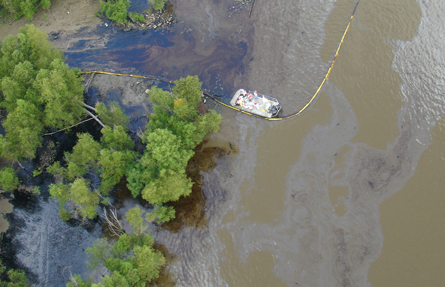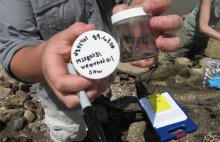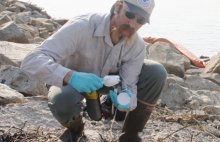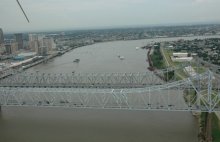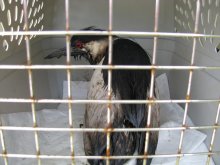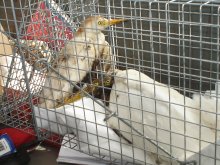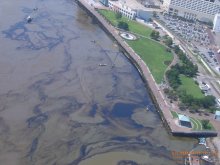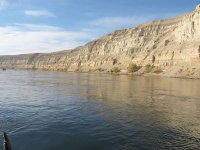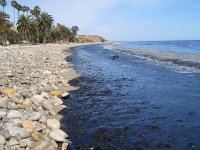Fuel Barge DM932
Oil Spill | Jefferson Parish, LA | July 2008
What Happened?
On July 23, 2008, the chemical tanker Tintomara collided with fuel barge DM932 on the Mississippi River, near downtown New Orleans. The Tintomara suffered minor damage, but the DM932 barge split into two sections. Within hours of the spill, NOAA's Office of Response and Restoration (OR&R) was on-scene, providing support for the cleanup and assessment of natural resource damages caused by the 270,000 gallons of spilled fuel oil.
In addition to harming wildlife, wetlands, and other coastal habitats, the incident resulted in significant economic disruption including extensive waterway closures, closure of municipal and industrial water intakes, and interference with critical channel dredging activities.
NOAA and other TrusteesGovernment officials acting on behalf of the public when there is injury to, destruction of, loss of, or threat to natural resources. worked cooperatively with the responsible party (RP)The individuals, companies, or government agencies responsible for an oil spill, hazardous substance release, or ship grounding incident., American Commercial Barge Line LLC (ACBL), to collect data and to assess injuries to natural resources as part of the natural resources damage assessment (NRDA)Investigation performed by trustees to identify injuries to natural resources caused by oil spills, hazardous substance releases, and grounding incidents in National Marine Sanctuaries, and plan restoration activities. The goal of NRDA is to restore natural resources and compensate the public for lost recreational use..
What Were the Impacts?
The oil spill affected over 100 miles of the Mississippi River downstream from New Orleans to Head of Passes, where the main stem of the Mississippi branches off into the Gulf of Mexico. A wide range of environments was impacted - from the waters of the river itself, to the shorelines, the forested wetland habitats between the river and levee (batture), and the downriver marshes. Several species of birds were also impacted, particularly wading birds and waterfowl such as herons and ducks. Additionally, the sediments at the bottom portion of the river were contaminated, and this disrupted future beneficial use of dredged sediments for marsh creation.
What’s Happening Now?
The trustees and ACBL reached a proposed settlement agreement valued at approximately $5.4 million to restore habitats injured by the spill. The Department of Justice lodged the Consent Decree in Federal District Court on October 4th, 2021, and it was finalized on November 18, 2021 after a public commenting period.
NOAA and its co-trustees also released the Final Damage Assessment and Restoration Plan and Environmental Assessment, Mississippi River Oil Spill, Gretna - New Orleans, Louisiana, July 23, 2008, which details the restoration projects that the trustees have selected to compensate the public for the natural resource damages resulting from this oil spill. The trustees’ selected restoration was developed as part of the cooperative NRDA, and through negotiations with ACBL on a potential settlement of its natural resource damage claims. Implementation of the restoration projects identified in the final plan is contingent upon final court approval of the lodged settlement agreement.
“As the largest river in the United States, the Mississippi River is a critical waterway for birds, fish, and other aquatic and riparian resources. The impacts from the spill were both ecological and recreational and the Trustees will strive to find projects that will help restore and preserve the natural resources of the Lower Mississippi.”
Dan Hahn
Office of Response and Restoration
Contacts
Daniel Hahn, Ph.D.
National Oceanic and Atmospheric Administration
Assessment & Restoration Division, SE Region
263 13th Avenue South
St. Petersburg, FL 33701
(727) 551-5715
Daniel.Hahn@noaa.gov

